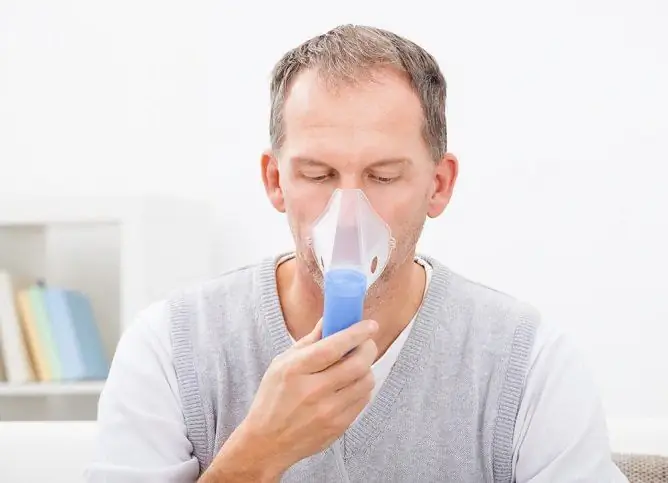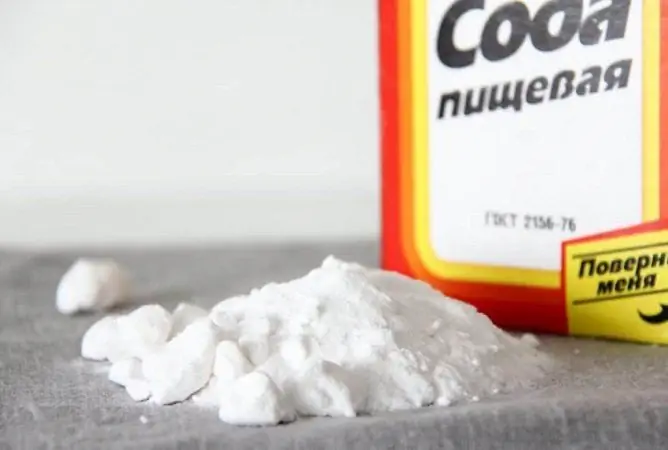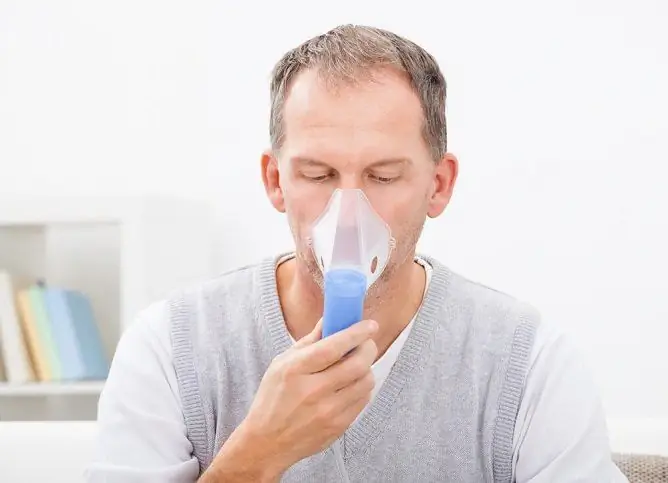- Author Rachel Wainwright [email protected].
- Public 2023-12-15 07:39.
- Last modified 2025-11-02 20:14.
Inhalation for sinusitis at home: recipes, reviews
The content of the article:
- Is it possible to do inhalations with sinusitis?
- How to inhale
-
How to treat sinusitis with inhalation
- Herbal inhalation
- Inhalation with essential oils
- Inhalation with Golden Star balm
- Potato inhalation
- Contraindications
- Video
Sinusitis is a condition in which inflammation affects the paranasal sinuses. It is caused by pathogens (viruses, bacteria) or damage to the nasal septum. The disease is more common in adults, since the formation of the maxillary sinuses begins after five years.

With sinusitis, steam inhalation helps to improve the ventilation capacity of the sinuses and reduce inflammation.
Sinusitis often develops as a complication of colds. In this case, the maxillary cavities are filled with purulent contents, the outflow of which is disturbed.
Is it possible to do inhalations with sinusitis?
Determine the acute and chronic form of the disease. In the first case, the main symptoms are manifested in the form of nasal congestion, mucopurulent discharge from the nasal sinuses, pain in the area of the affected sinus and headaches, which intensify in the evening or when bending forward.
If the acute stage of the disease is not completely cured, then the disease becomes chronic and often recurs. In this case, the same symptoms may be observed as in acute sinusitis, but they are not so pronounced. The therapy is carried out with the help of antibiotics, since most often it is caused by a bacterial infection.
It must be remembered that inhalations can only be carried out with a chronic form of the disease in the stage of incomplete remission. The procedure will help improve the ventilation capacity of the sinuses and reduce inflammation. With purulent sinusitis, steam inhalation can be harmful and lead to complications.
How to inhale
Inhalation can be done at home. The simplest and most affordable method is steam inhalation. They need a container into which the solution is poured and a towel.
The hot liquid is poured into a bowl, and they bend over it, covering their head with a towel. The procedure is carried out until the solution cools down and the steam stops escaping. Most often, decoctions of medicinal herbs or essential oils are used for treatment. For such procedures, a heat-moisture inhaler can be used. It consists of a cup into which the solution is poured and a mask.

A heat-and-moisture inhaler is a device designed for performing inhalation procedures at home
Also, for the treatment of sinusitis, inhalation with a nebulizer can be performed. This is a special device that sprays medicinal substances into very small particles. However, the steam they turn into remains cold.

In the treatment of sinusitis, inhalations can be performed using a nebulizer
For the procedure, not herbal decoctions and essential oils are used, but medicines, for example:
- Fluimucil-antibiotic IT;
- Dioxidine;
- Dekasan;
- Lazolvan;
- Sinupret;
- Chlorophyllipt (alcohol solution).
They are pre-diluted with isotonic sodium chloride solution (saline). Also for inhalation with a nebulizer, pure saline solution or mineral water can be used. You cannot use boiled water to dilute the medicine, as this can cause bronchospasm.
How to treat sinusitis with inhalation
Herbal inhalation
Steam inhalations for sinusitis, which are based on decoctions of medicinal herbs, are very popular. For the procedure, you can use plants with a pronounced anti-inflammatory effect. So what to do inhalations with sinusitis, which herbs help better?

Most often, chamomile decoction is used for steam inhalations.
The most effective remedies, according to patients' reviews, include chamomile, calendula, oak bark, sage, oregano. Also, for this procedure, you can purchase a ready-made collection of Elekasol at the pharmacy.
In preparation for the procedure, one tablespoon of raw materials is poured into 1/2 l of water and boiled over low heat for up to 5 minutes. Then the broth is covered with a lid and allowed to cool to a comfortable temperature.
Such a product can be poured into a warm-humid inhaler and breathed over the steam. But you need to remember that decoctions of medicinal herbs cannot be used for a nebulizer.
Inhalation with essential oils
Often in the treatment of sinusitis, inhalations with essential oils are carried out. The procedure is carried out with oil of eucalyptus, tea tree, cedar, fir, Siberian pine, oregano, lemon. They have a mild anti-inflammatory effect and are effective against pathogenic microbes that cause the development of the disease.

For inhalation, add a few drops of lemon essential oil to hot water.
In order to carry out inhalation, a few drops of oil are added to hot water, and breathe, bending over the steam. With a purulent form of the disease, oils are simply added to the aroma lamp, and their smell is inhaled, which has a positive effect on the body.

When treating purulent sinusitis, essential oils can be added to the aroma lamp
Essential oils cannot be used for inhalation with a nebulizer, since they break up into small particles under air pressure and settle in the lungs, which can lead to edema and death.
Inhalation with Golden Star balm
The famous balm called the Golden Star (Star) is popular. It contains Chinese cinnamon, cloves, mint, eucalyptus, camphor. The drug has not only a pungent odor, but also an antiseptic, anti-inflammatory and mucolytic effect.

Due to the properties of active ingredients, the Golden Star balm is effective in the treatment of sinusitis
For the treatment of sinusitis by inhalation in 1 liter of boiling water, add one tablespoon of sea salt and a small piece of balm (the size of a pea). The aromatic vapors are inhaled for 15-20 minutes.
Potato inhalation
Potato inhalation is the most popular method that has been used for many generations and is far from the last among the recipes for non-traditional treatment of sinusitis. Inhalation of potato vapor can improve the respiratory function of the nose, relieve inflammation, soften mucus and improve its outflow.
Boil the potatoes with the peel and drain the water. After the temperature of the steam has dropped slightly, cover yourself with a towel and bend over the pan. The procedure is carried out for 7-10 minutes daily for a week.
Contraindications
Steam inhalation is not recommended in the following cases:
- purulent inflammation;
- an acute form of sinusitis, if the patient has a high body temperature and feeling unwell;
- the presence of a cyst in the sinus;
- diseases of the cardiovascular system;
- individual intolerance to the components of the agent, on the basis of which the solution for inhalation is made.
Before starting inhalation with sinusitis at home, you should consult with an otolaryngologist.
Video
We offer for viewing a video on the topic of the article.

Anna Kozlova Medical journalist About the author
Education: Rostov State Medical University, specialty "General Medicine".
Found a mistake in the text? Select it and press Ctrl + Enter.






